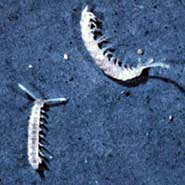


Symphylans
Description
Symphylans look similar to centipedes with their long, segmented bodies, but they are much smaller, measuring 1/16 to 1/4 inch in length. They have 10 to 12 pairs of legs, long antennae, and they are usually white or light gray in color. They will sometimes feed on the roots of African Violets, but generally cause very little damage.
Distinguishing Symptoms
If your African Violet has this symptom, it probably has Symphylans.
Treatment
First, isolate all affected Violets in order to prevent further spread. Treat the entire plant, including the rootball, with a household insect spray containing Acephate. Apply as directed on the label, and be careful not to spray too much. Too much Acephate may cause damage to the leaves. (Note: Many household insect sprays, which contain Acephate, also contain a specific additive that may damage the foliage of African Violets. Therefore, if available, use a soluble powder, and mix your own spray.)
Prevention
Keep soil clean of leaf and flower debris, where Symphylans tend to seek shelter.
Important Note on the Use of Pesticides
Please note that almost all pesticides are formulated for specific uses and conditions. When applied incorrectly, pesticides can cause ill health or damage to plants. Therefore, when using any kind of pesticide or chemical treatment, always apply as indicated on the product label.
 |
| Begin New Diagnosis |
| Doctor Optimara Main Page | Glossary of Violet Terms | Contact Optimara |
| Pests, Pathogens and Cultural Problems (Complete List) |
Copyright 1999 Optimara/Holtkamp Greenhouses, Inc. Nashville, Tennessee. Doctor Optimara is a trademark of Holtkamp Greenhouses, Inc. Optimara and the Optimara logo are trademarks of International Plant Breeding, A.G., Switzerland.